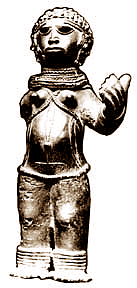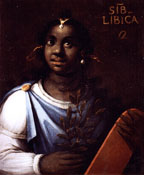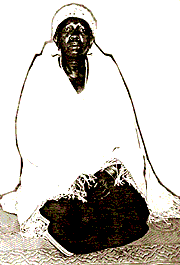AFRICA: Visual Talks by Max DashuAll titles are in-person visual presentations (average 90 minutes)
with a break midway and more time for questions and discussion. Tech requirements: digital projector with VGA cable, screen, and mic.
Ancient Treasures of African Women, Parts I and II

Kemetic Deasophy: Egyptian Goddesses
Suppressed Histories: Ethiopia
Suppressed Histories: Zimbabwe
(click links above to view full-page descriptions)
Suppressed Histories: the Sahara
"Women and men towards each other are for the eyes and the heart, and not only for the bed." --Tuareg proverb
Ancient petroglyphs and the rich archaeology of Saharan civilization: murals of the Tassili, Oran, Fezzan; megalithic monoliths, mounds and circles. Ancient ceramics of Chad. The matrilineal Tuareg (Imohagh) whose female drummers, scribes and bard-historians sing of founding ancestral mothers. The nomadic Wodaabe people: women's calabash art and altars, men's beauty contests. The fight for cultural survival amidst drought and globalization.
Suppressed Histories: Egyptian Women
"I have come from the school of medicine at Heliopolis, and have studied at the women's school at Sais where the divine mothers have taught me how to cure diseases." --Egyptian inscription
Archaeology of Kemet ("Black"): ancient Egypt, mother of knowledge. The respected status of Kemetic women, farmers, businesswomen, weavers, and musicians. Nefert-Abet, Ahmose Nefertari, Hatshepsut. Assyrian, Persian, Greek, Roman and Arab conquests. Gnostics, Christians and Muslims.
Suppressed Histories: Nubia and Sudan
"It is said to be the custom among the Nubians, when a king dies and leaves a son, and also a nephew, the son of his sister, that the latter reigns after his uncle, instead of the son..."
--Abu Salih, the ArmenianCeramic images of women in the long Sudanese neolithic, the Kerma culture and other classic early Nubian civilizations. The priestess-queens of Napata and Meroe (and the breathtaking art in their temples and tombs) and the ascension of a Nubian dynasty in Egypt, saving the country from foreign invaders. The Nubian goddesses Anuket, Satet, and great Auset (Isis), defended into the 6th century CE by the Bejas (Medjay / Blemmyes). Glories of Meroitic sculpture, ceramics, and other arts. The Nuba and the persistence of Nubian matrilineage and village culture, amidst millennia of resistance to slave-raids.
Suppressed Histories: the Sahel
O Eagle, only treachery can destroy familial love.
Descendance from the woman,
descendance from the woman has ended.
But descendence from the woman is better than sterility
And sterility is better than an evil child.
—Duga , a Bambara epic of Mali
Ceramic art of the inland delta of the Niger. Dogon traditions: the Seventh Nummo, Yasinyé of the red fibers. Bosso legends of Pa Sini Jobu. Timbuktu, "place of Buktu," and other ancestral mothers in oral tradition. Bori magadjiyar: pagan priestesses of the Hausa. The nine sorceresses of Mande. Bambara: female creator, courageous ancestral mothers and the Gouan staffs. Advent of Islam and "cutting open Mune." Empires of Ghana, Mali, Songhay and Kanem-Bornu. The Mossi mother who killed a tyrant. Queens, calabash artists and farmers across the north central Africa plain from Walata to Darfur.
Suppressed Histories: Nigeria
"Here there converged some 10,000 women... girdled with green leaves, carrying sticks. Singing angry songs against the chiefs and court messengers, the women proceeded to attack and loot the European trading shops, stores, and Barclay's Bank, and to break into the prison and release the prisoners."
-- British district officer at Bende.1929Ancient cultures of Nok and Ilé-Ifé. Images of women in the art of Esie, Benin, and Igbe-Ukwu. Priestesses, queens, weavers, potters and farmers. Female orishas and the mysteries of Odu. Cultural legacies of the Yoruba in the African Diaspora. The power of women's councils, such as the revolt of Igbo market women in the Women's War, a major African rising against colonial rule. Modern women's movements, legal activists in Hausa country, and the Niger delta movement of indigenous people.
The MAGHREB
My Sahara stretched along the edge, my parents remembered that they'd been nomads and I, little barefoot girl, would run on top of the dune... --Women of Algiers in Their Apartment
Algeria, Tunisia, Libya, Morocco, and Mauretania. Rock art and megalithic monuments of the ancients: stone circles, dolmens and other formations. Stelae of the goddess Tanit and the priestesses of Carthage. Dahia la Kahina and Karsifa, warrior queens who resisted the Arab conquest. Amazigh ("Berber") dance, drumming, weaving and ceramics. Modern colonizations and liberation movements, including feminism.
WEST AFRICA
"You know that in our country there were even matriarchal societies where women were the most important element. On the Bijagos islands they had queens. They were not queens because they were the daughters of kings. They had queens succeeding queens. The religious leaders were women too..." ---Amilcar Cabral, Return to the Source, 1973
Female rulers, artists, priestesses, and market women in Dahomey, Togo, Ghana, Ivory Coast, Liberia, Sierra Leone, Guinée and Senegal. The power of women's associations. Abla Poku, founder of the Baulé nation, and other female ancestors. Ashanti matrilineage, queens, and the signs of goddess Nyame in Adinkra cloth. Yaa Asaantewa in the Ghanaian resistence to English colonization. Women warriors and priestesses of Dahomey.
The AFRICAN HEARTLAND
Cameroon, Gabon, Congo, Central African Republic. Mpongwe Masks, Kasai velvets of the BaKuba women, barkcloth of the BaMbuti, ceramics of the Mangbetu. Female chieftains and officials among the BaLunda and BaChokwe, with traditions of a struggle between matrilineal and patriarchal systems. Women among the Azande, Bapende, BaKongo, BaLuba and other peoples.
SOUTH AFRICA
"... I was born of a lioness, child of Soasoane
It is fitting that I should emulate her.
She is my mother, she strapped me on her back
I was nursed by lions that wore skirts."
—Basotho epicPaleolithic rock murals of the San people. Khoi-Khoi, Swazi, !Xhosa, Venda and Zulu women. Female diviners and doctors. The Lovedu rain priestesses. Murals of Ndebele women, Zulu baskets and pottery. Womanhood initiations. Female farmers. Boers, Brits, and the apartheid state. Women in the ANC and constitutional reform. Modern women's activism around lobolo/bride price and the sexual politics of rape, consent, and AIDS.
SOUTHWEST AFRICA
Angola, Namibia, and Botswana. Women of the Khoi-khoi and San peoples. The western end of the south-central African matrilineal belt, and contradictions posed by systems which are matrilineal but patrilocal. Foundational queens: Nilwa of the Nkumbi and Ruwej of the BaChokwe as well as the important royal women of Ongandjera. Women of the Himba and Herero. The German genocide of the early 20th century, and the South African and U.S. proxy wars of the 1980s. Women's activism in the present day.



